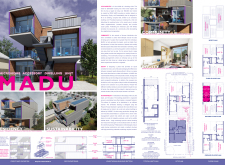5 key facts about this project
At its core, the project represents a sustainable approach to housing, addressing not just the immediate need for affordable and diverse living arrangements but also fostering a sense of community. The architecture is designed to function as a flexible microhome, providing essential residential features while occupying a minimal footprint on the urban landscape. This unique duality enhances its role as both a holiday retreat and a year-round home, capable of accommodating various occupants and lifestyles.
The design of Madu is characterized by clarity and intentionality, featuring a combination of modern materials that collectively create a warm and inviting atmosphere. The chosen elements include wood cladding, metal panels, and expansive glass surfaces, each contributing to the overall visual appeal and functionality of the structure. The wood cladding not only adds aesthetic warmth but also signifies a commitment to renewable resources, aligning with the sustainability ethos woven throughout the design. Metal panels enhance durability and reduce maintenance needs, while large glass windows and sliding doors optimize natural light and air circulation, effectively bridging the indoor spaces with the outdoor environment.
A distinctive feature of the Madu project is its adaptive layout. The design includes flexible floor plans that can easily be modified to suit the changing needs of occupants over time. This emphasis on adaptability enhances the project's relevance, allowing it to remain functional in the face of shifting demographics and housing demands. Communal areas, thoughtfully incorporated into the layout, create opportunities for interaction, reinforcing social ties among residents.
In terms of unique design approaches, Madu stands out for its careful consideration of urban context. The structure is sited to maintain a harmonious scale with neighboring homes, avoiding overpowering existing buildings while still making a significant architectural statement. Furthermore, the project incorporates resilient building strategies, such as energy-efficient systems and solar panels, that contribute to its long-term sustainability and operational efficiency. By employing passive housing techniques, Madu effectively reduces energy consumption while ensuring the comfort of its residents.
This project serves as an exemplar of how contemporary architecture can address current social and environmental challenges. It not only focuses on providing housing but also engages with sustainability and community building in a meaningful way. Madu is a clear illustration of how thoughtful architectural decisions can lead to positive outcomes for individuals and communities alike.
For additional insights into this project, including architectural plans, architectural sections, and architectural designs, further exploration of the presentation materials is encouraged. Engaging with these elements will deepen your understanding of the innovative ideas that underpin the Madu Microhome ADU project and its implications for future architectural practices.























